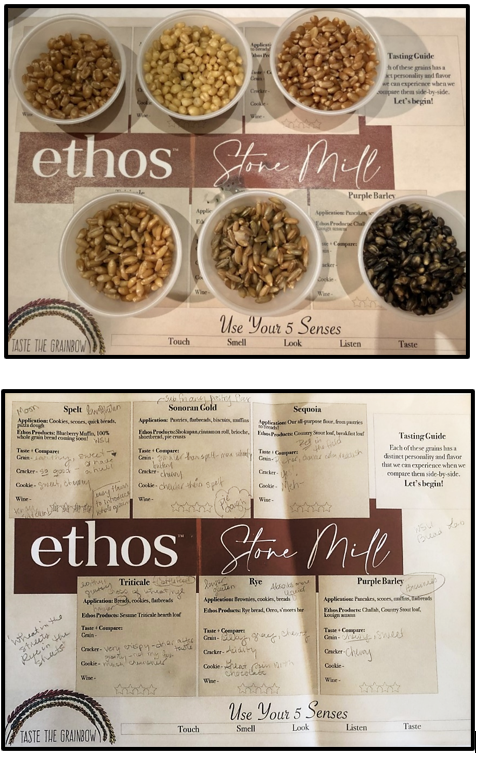Traditional American Thanksgiving commemorations are heir to influences contributed by early Pilgrim colonists and their Native American neighbors, as well as later European immigrant groups with their harvest feast customs. Longer growing seasons in North America led to later commemorations of harvest festivals, and today’s popular county and state fairs in late summer and fall continue this tradition of agrarian spectacle, revelry, and fellowship. Nineteenth century historian William DeLoss Love’s study of early America indicates that both the Plymouth and Massachusetts Bay colonists irregularly held days of fasting and humiliation as well as thanksgiving.
Colonial Williamsburg Lammas Wheat Harvest
(Seed stock provided by Palouse Heritage)
Ed Schultz Photograph
Love describes one of the first Plymouth references to a thanksgiving feast involving charity to the less fortunate on December 22, 1636 in Reverend John Lothrop’s congregation at Scituate. Such celebrations among the New England colonists do not appear to have become annual events until about the middle of the 17th century, and not until the 1660s is frequent reference found to gratitude for “the fruits of the earth.” Customary communal fare on such occasions included venison and fish, clams and oysters, squash and beans, and berry puddings and apple pie. While cranberries were also popular, consumption of any turkey at these early events apparently was incidental.
President George Washington issued the first national Thanksgiving proclamation in 1789, the year of his inauguration. He designated the last Thursday in November “to be devoted by the people of these States to… the Beneficent Author of all the good that was, that is, or that will be.” This time was associated with the growing New England Thanksgiving tradition and observations of Christian Whitsuntide and the Jewish Feast of Ingathering (Sukkot, or Tabernacles). Some governors and denominations, however, objected to civil involvement in religious affairs so the day came to be celebrated according to regional preferences, or not at all.
One of the 19th century’s most tireless advocates for a true nationwide commemoration of Thanksgiving was longtime Ladies’ Magazine Boston editor Sarah Josepha Hale. Launching her crusade in 1827, Hale wrote hundreds of letters to public officials to further the cause, and in 1863 composed an influential editorial offering explicit association between Thanksgiving and Old Testament tradition: “Can we not then, following the appointment of Jehovah in the ‘Feast of Weeks,’ or Harvest Festival, establish our yearly Thanksgiving as a permanent American National Festival which shall be celebrated on the last Thursday in November in every State of the Union?” Hale’s magazine provided a forum for many of era’s finest writers whose works, like these lines from Longfellow’s “Thanksgiving,” she featured to advance her abiding campaign.
Hale’s plea reached the White House, and on October 3, 1863 President Lincoln designated the last Thursday in November as an annual national observance of the holiday. (Since 1879, Thanksgiving in Canada has been celebrated on the second Monday in October.) Lincoln’s proclamation, issued in the midst of the Civil War, attests to his regard for sacred responsibilities: “The year that is drawing toward its close has been filled with the blessings of fruitful fields and healthful skies. To these bounties, which are so constantly enjoyed that we are prone to forget the source from which they come, others have been added, which are of so extraordinary nature that they cannot fail to penetrate and soften the heart which is habitually insensible to the ever watchful presence of almighty God.”
Many Thanksgiving hymns evoke agricultural images with spiritual significance, as with Henry Alford’s “Come Ye Faithful People, Come,” (1844) which remains one of the most popular of all such festival songs:
Come, ye faithful people, come
Raise the song of Harvest-Home.
Grant a harvest Lord, that we
Wholesome grain and pure may be.
By the late 19th century, many commemorations of Harvest-Home in America had become conflated with Thanksgiving in ways that still celebrated agrarian bounty and labor in the context of divine blessing. Genteel Harvest-Home “socials” were a regular feature of Northwest rural school programs well into the 1990s. (Harvest-Home also graced the nameplate of a full-rigged barque that regularly plied Puget Sound ports in the 1870s and ‘80s to load flour, lumber, and other cargo for California markets.)
Edwin Molander, Grain Sheaf Wall Panel (1949)
Trinity Lutheran Church, Endicott, Washington
American traditions of Thanksgiving have been influenced by an enriching cultural milieu including colonial New England commemorations, European Harvest-Home customs, and biblical observances of harvest feasts. Efforts in the early years of the republic and during the Civil War were designed to promote national unity through formal proclamation of the holiday, but aspects of the commemoration had long lived in the population’s experience, and in an array of other folk traditions later brought by immigrants hoping to find new opportunity for a safe and prosperous life. The Jewish Feast of the Harvest, Harvest-Home, and Thanksgiving are rooted in the descent, humble recognition that deliverance from want and tyranny is a hope common to all humanity, and finds its expression in prayers of thanks for the Creator’s blessings, and in the festive, inclusive fellowship of family, friends, and newcomers.









